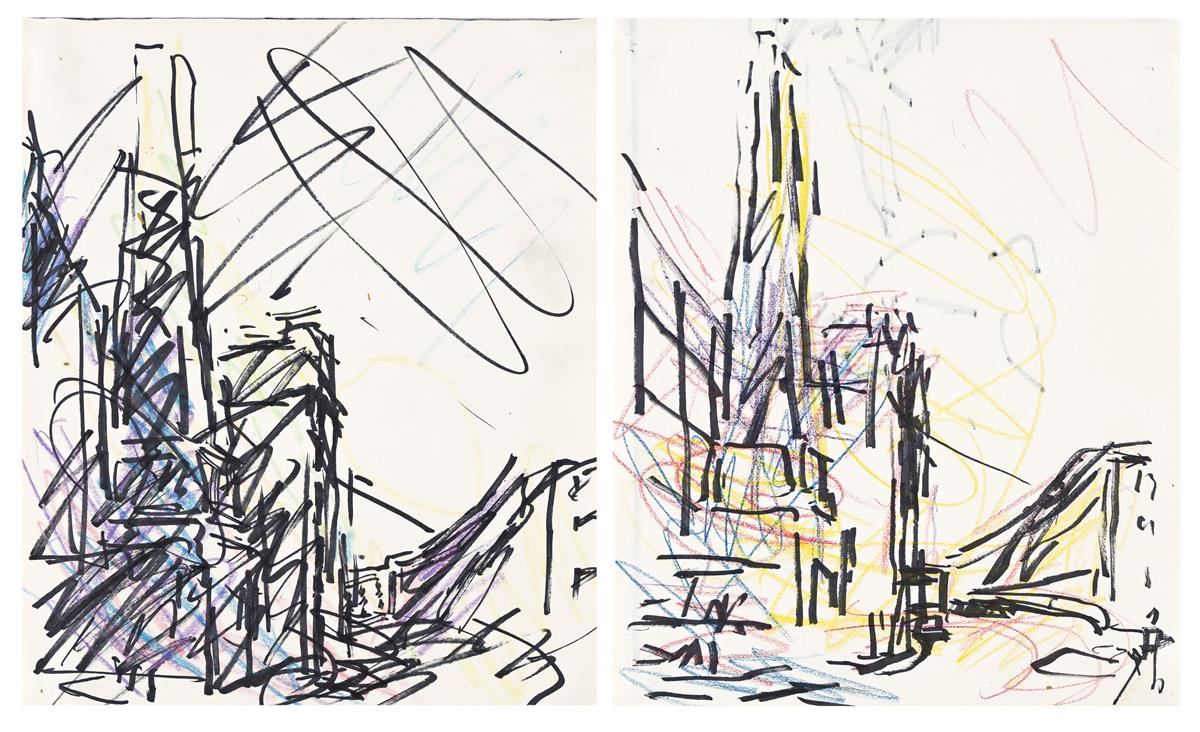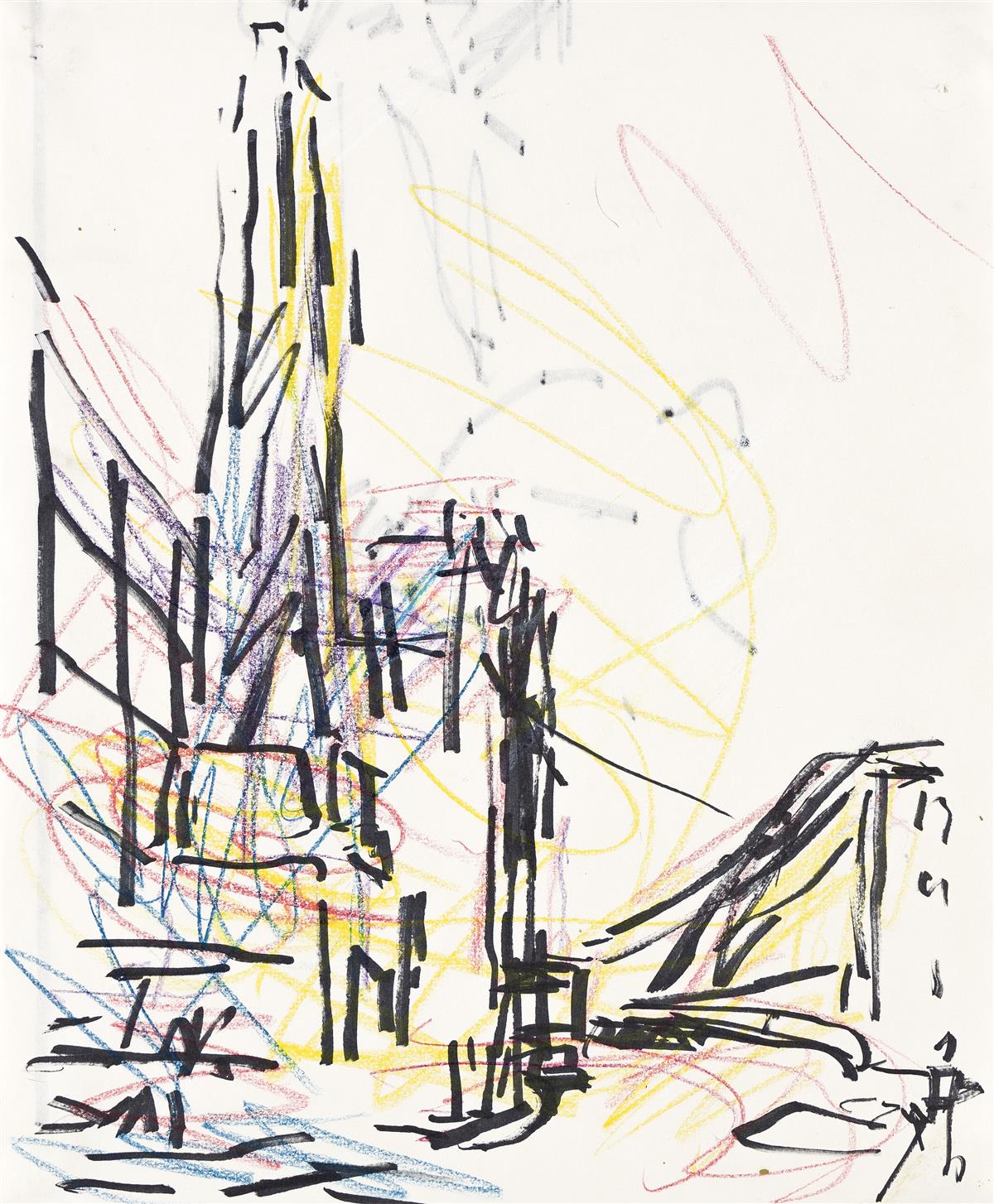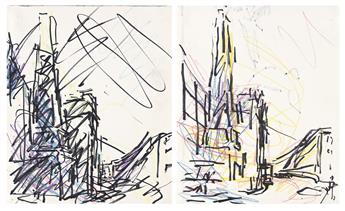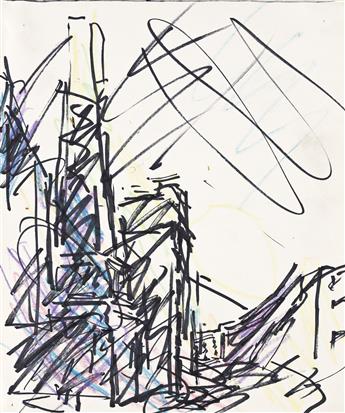Sale 2630 - Lot 442
Price Realized: $ 18,000
Price Realized: $ 22,500
?Final Price Realized includes Buyer’s Premium added to Hammer Price
Estimate: $ 12,000 - $ 18,000
FRANK AUERBACH
Study for Chimney in Mornington Crescent.
Ink and crayon on paper diptych, 1987-88. The sheets, 355x298 mm; 14x11 3/4 inches, and 363x297 mm; 14 1/4x11 3/4. Each sheet signed, titled, and dated in pencil, verso.
Provenance: Marlborough Fine Art, Ltd., London, with the label; with Livet Reichard Company, Inc., New York, 1993; private collection, New York.
Exhibited: Peggy Guggenheim Collection, Venice, "Drawing the Line Against AIDS," June 8-13, 1993, with the label.
According to the Tate Modern museum, London, which has works from this series in the collection, Mornington Crescent depicts a, "Subject that Auerbach [born 1931] has explored extensively since moving to his studio in Camden Town, North London, in 1954: landscapes representing the nearby streets, buildings and parks, particularly Primrose Hill, that he knows intimately and which he has continued to draw and paint over six decades. There are three works relating to this subject [Mornington Crescent–Summer Morning] in Tate's collection: Primrose Hill, 1967–80, To the Studios, 1979–80, and To the Studios, 1990–91.
Landscape paintings such as Mornington Crescent–Summer Morning usually take as a starting point a number of drawings made by the artist in situ, with the final composition being arrived at in the studio. Auerbach often returns to the site to make further drawings and fresh observations which are then developed in the painting back in the studio. Each work is usually the result of a long process of cyclical painting and erasure, with the artist scraping and blotting off the paint while still fresh, and re-starting the entire work numerous times. Nevertheless, this does not equate to starting afresh on a bare canvas: traces of the previous painting remain on the canvas and each previous version is the starting point for a new one.
The execution of each painting is the result of great physical effort, as arriving at the ultimate version of the composition demands numerous hours of intense activity. The work is also the result of the artist's direct engagement with the subject, accepting and rendering the sensations and instinctive reactions to what is being depicted. Auerbach has stated: ‘I am working on the structure of the painting; whatever else that comes through is not conscious' (quoted in Ordovas 2013, page 13). He goes on to explain that each work embodies something more personal than just its immediate subject matter: ‘it's never just topography, it is never just recording the landscape. It always has to do with some sort of feeling about my life' (quoted in Ordovas 2013, page 17). Of the specific subject depicted here [in Mornington Crescent–Summer Morning], he has said: 'I haven't painted [Mornington Crescent] to ally myself with some Camden Town Group, but simply because I feel London is this raw thing . . . This extraordinary, marvelously unpainted city where whenever somebody tries to get something going they stop halfway through, and next to it something incongruous occurs . . . this higgledy-piggledy mess of a city'."
Study for Chimney in Mornington Crescent.
Ink and crayon on paper diptych, 1987-88. The sheets, 355x298 mm; 14x11 3/4 inches, and 363x297 mm; 14 1/4x11 3/4. Each sheet signed, titled, and dated in pencil, verso.
Provenance: Marlborough Fine Art, Ltd., London, with the label; with Livet Reichard Company, Inc., New York, 1993; private collection, New York.
Exhibited: Peggy Guggenheim Collection, Venice, "Drawing the Line Against AIDS," June 8-13, 1993, with the label.
According to the Tate Modern museum, London, which has works from this series in the collection, Mornington Crescent depicts a, "Subject that Auerbach [born 1931] has explored extensively since moving to his studio in Camden Town, North London, in 1954: landscapes representing the nearby streets, buildings and parks, particularly Primrose Hill, that he knows intimately and which he has continued to draw and paint over six decades. There are three works relating to this subject [Mornington Crescent–Summer Morning] in Tate's collection: Primrose Hill, 1967–80, To the Studios, 1979–80, and To the Studios, 1990–91.
Landscape paintings such as Mornington Crescent–Summer Morning usually take as a starting point a number of drawings made by the artist in situ, with the final composition being arrived at in the studio. Auerbach often returns to the site to make further drawings and fresh observations which are then developed in the painting back in the studio. Each work is usually the result of a long process of cyclical painting and erasure, with the artist scraping and blotting off the paint while still fresh, and re-starting the entire work numerous times. Nevertheless, this does not equate to starting afresh on a bare canvas: traces of the previous painting remain on the canvas and each previous version is the starting point for a new one.
The execution of each painting is the result of great physical effort, as arriving at the ultimate version of the composition demands numerous hours of intense activity. The work is also the result of the artist's direct engagement with the subject, accepting and rendering the sensations and instinctive reactions to what is being depicted. Auerbach has stated: ‘I am working on the structure of the painting; whatever else that comes through is not conscious' (quoted in Ordovas 2013, page 13). He goes on to explain that each work embodies something more personal than just its immediate subject matter: ‘it's never just topography, it is never just recording the landscape. It always has to do with some sort of feeling about my life' (quoted in Ordovas 2013, page 17). Of the specific subject depicted here [in Mornington Crescent–Summer Morning], he has said: 'I haven't painted [Mornington Crescent] to ally myself with some Camden Town Group, but simply because I feel London is this raw thing . . . This extraordinary, marvelously unpainted city where whenever somebody tries to get something going they stop halfway through, and next to it something incongruous occurs . . . this higgledy-piggledy mess of a city'."
Exhibition Hours
Exhibition Hours
Aliquam vulputate ornare congue. Vestibulum maximus, libero in placerat faucibus, risus nisl molestie massa, ut maximus metus lectus vel lorem.








